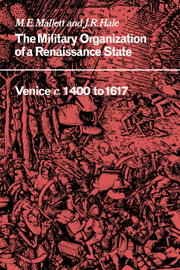Book contents
- Frontmatter
- Contents
- List of illustrations
- Acknowledgements
- References and abbreviations
- Map 1 The Terraferma in the fifteenth and sixteenth centuries
- Map 2 The empire da Mar
- PART I c. 1400 to 1508
- PART II 1509–1617
- 8 The historical role of the land forces 1509–1617
- 9 The wars
- 10 Government: policy, control and administration
- 11 The higher command
- 12 Manpower
- 13 Cavalry, infantry, artillery
- 14 Fortifications in the Terraferma
- 15 The defence of the maritime empire
- 16 The costs of defence and war
- Conclusion: the European context 1525–1617
- Appendix Infantry wages in the sixteenth century
- Select bibliography
- Index
11 - The higher command
Published online by Cambridge University Press: 22 October 2009
- Frontmatter
- Contents
- List of illustrations
- Acknowledgements
- References and abbreviations
- Map 1 The Terraferma in the fifteenth and sixteenth centuries
- Map 2 The empire da Mar
- PART I c. 1400 to 1508
- PART II 1509–1617
- 8 The historical role of the land forces 1509–1617
- 9 The wars
- 10 Government: policy, control and administration
- 11 The higher command
- 12 Manpower
- 13 Cavalry, infantry, artillery
- 14 Fortifications in the Terraferma
- 15 The defence of the maritime empire
- 16 The costs of defence and war
- Conclusion: the European context 1525–1617
- Appendix Infantry wages in the sixteenth century
- Select bibliography
- Index
Summary
‘We have a fine army, but it needs a leader’; a supreme commander ‘is as necessary to an army as a soul is to the body’. These reflections of 1510 were to be drastically reinterpreted as the century wore on.
At that date, however, tradition had also established that armies should be directed, albeit under political supervision, by professional soldiers and that the supreme command should be divided between a captain-general, associated with the numerically superior infantry, and a governor-general, identified with the cavalry. The relationship between the two was not always defined in their contracts, though when it was it was made clear that the governor-general should accept orders from the captain-general. All the same, problems raised by the definition of these commands led Venice to maintain both a captain- and a governor-general very rarely: only in 1509–10, 1513–15 and 1529–30.
The events of 1510 show some of the difficulties involved in giving the army a soul. Venice's captain-general, Pitigliano, as a member of a family that was firmly anti-German and had provided Venice with captains for a hundred years (and was to do so for another) was made an honorary patrician on 25 February 1509 by being elected to the Great Council – ‘he and his sons and legitimate descendants’. But the outcome of Agnadello was not such as to increase the government's confidence, nor was his by now advanced age, and four days after the battle the proveditors-general, referring to the indiscipline and confusion that reigned in the army, referred to him as ‘worthless’.
- Type
- Chapter
- Information
- The Military Organisation of a Renaissance StateVenice c.1400 to 1617, pp. 284 - 312Publisher: Cambridge University PressPrint publication year: 1984
- 1
- Cited by



